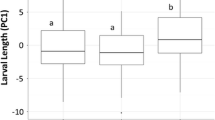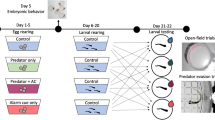Abstract
Amphibians are able to learn to recognize their future predators during their embryonic development (the ghost of predation future). Here, we investigate whether amphibian embryos can also acquire additional information about their future predators, such as the level of threat associated with them and the time of day at which they would be the most dangerous. We exposed woodfrog embryos (Rana sylvatica) to different concentrations of injured tadpole cues paired with the odor of a tiger salamander (Ambystoma tigrinum) between 1500 and 1700 hours for five consecutive days and raised them for 9 days after hatching. First, we showed that embryos exposed to predator odor paired with increasing concentrations of injured cues during their embryonic development subsequently display stronger antipredator responses to the salamander as tadpoles, thereby demonstrating threat-sensitive learning by embryonic amphibians. Second, we showed that the learned responses of tadpoles were stronger when the tadpoles were exposed to salamander odor between 1500 and 1700 hours, the time at which the embryos were exposed to the salamander, than during earlier (1100–1300 hours) or later (1900–2100 hours) periods. Our results highlight the amazing sophistication of learned predator recognition by prey and emphasize the importance of temporal considerations in experiments examining risk assessment by prey.


Similar content being viewed by others
References
Anholt BR, Skelly DK, Werner EE (1996) Factors modifying antipredator behavior in larval toads. Herpetologica 52:301–313
Berejikian BA, Tezak EP, LaRae AL (2003) Innate and enhanced predator recognition in hatchery-reared chinook salmon. Environ Biol Fisches 67:241–251
Blaustein AR, Bancroft BA (2007) Amphibian population declines: evolutionary considerations. Bioscience 57:437–444
Blaustein AR, Kiesecker JM (2002) Complexity in conservation: lessons from the global decline of amphibian populations. Ecol Lett 5:597–608
Brown GE (2003) Learning about danger: chemical alarm cues and local risk assessment in prey fishes. Fish Fish 4:227–234
Chivers DP, Mirza RS (2001a) Importance of predator diet cues in responses of larval wood frogs to fish and invertebrate predators. J Chem Ecol 27:45–51
Chivers DP, Mirza RS (2001b) Predator diet cues and the assessment of predation risk by aquatic vertebrates: a review and prospectus. In: Marchlewska DA, Lepri JJ, Müller-Schwarze D (eds) Chemical signals in vertebrates. Plenum Press, New York, pp 277–284
Chivers DP, Smith RJF (1998) Chemical alarm signalling in aquatic predator-prey systems: a review and prospectus. Ecoscience 5:338–352
Chivers DP, Mirza RS, Bryer PJ, Kiesecker JM (2001) Threat-sensitive predator avoidance by slimy sculpins: understanding the importance of visual versus chemical information. Can J Zool 79:867–873
Chivers DP, Zhao X, Ferrari MCO (2007) Linking morphological and behavioural defences: prey fish detect the morphology of conspecifics in the odour signature of their predators. Ethology 113:733–739
Chivers DP, Zhao X, Brown GE, Marchant TA, Ferrari MCO (2008) Predator-induced changes in morphology of a prey fish: the effects of food level and temporal frequency of predation risk. Evol Ecol 22:561–574
Ferrari MCO, Chivers DP (2008) Cultural learning of predator recognition in mixed-species assemblages of frogs: the effect of tutor-to-observer ratio. Anim Behav 75:1921–1925
Ferrari MCO, Chivers DP (2009) Temporal variability, threat-sensitivity and conflicting information about the nature of risk: understanding the dynamics of tadpole antipredator behaviour. Anim Behav 78:11–16
Ferrari MCO, Trowell JJ, Brown GE, Chivers DP (2005) The role of learning in the development of threat-sensitive predator avoidance by fathead minnows. Anim Behav 70:777–784
Ferrari MCO, Messier F, Chivers DP (2006) The nose knows: minnows determine predator proximity and density through detection of predator odours. Anim Behav 72:927–932
Ferrari MCO, Gonzalo A, Messier F, Chivers DP (2007a) Generalization of learned predator recognition: an experimental test and framework for future studies. Proc R Soc B 274:1853–1859
Ferrari MCO, Messier F, Chivers DP (2007b) Degradation of chemical alarm cues under natural conditions: risk assessment by larval woodfrogs. Chemoecology 17:263–266
Ferrari MCO, Messier F, Chivers DP (2007c) First documentation of cultural transmission of predator recognition by larval amphibians. Ethology 113:621–627
Ferrari MCO, Messier F, Chivers DP (2008a) Can prey exhibit threat-sensitive generalization of predator recognition? Extending the predator recognition continuum hypothesis. Proc R Soc B 275:1811–1816
Ferrari MCO, Messier F, Chivers DP (2008b) Larval amphibians learn to match antipredator response intensity to temporal patterns of risk. Behav Ecol 19:980–983
Ferrari MCO, Messier F, Chivers DP (2008c) Threat-sensitive learning of predators by larval mosquitoes Culex restuans. Behav Ecol Sociobiol 62:1079–1083
Ferrari MCO, Sih A, Chivers DP (2009) The paradox of risk allocation: a review and prospectus. Anim Behav 78:579–585
Gosner KL (1960) A simplified table for staging anuran embryos and larvae with notes on identification. Herpetologica 16:183–190
Goth A (2001) Innate predator-recognition in Australian brush-turkey (Alectura lathami, Megapodiidae) hatchlings. Behaviour 138:117–136
Griffin AS, Evans CS, Blumstein DT (2001) Learning specificity in acquired predator recognition. Anim Behav 62:577–589
Hamilton IM, Heithaus MR (2001) The effects of temporal variation in predation risk on anti-predator behaviour: an empirical test using marine snails. Proc R Soc B 268:2585–2588
Helfman GS (1989) Threat-sensitive predator avoidance in damselfish–trumpetfish interactions. Behav Ecol Sociobiol 24:47–58
Hepper PG, Waldman B (1992) Embryonic olfactory learning in frogs. Q J Exp Psychol 44B:179–197
Kats LB, Petranka JW, Sih A (1988) Antipredator defenses and the persistence of amphibian larvae with fishes. Ecology 69:1865–1870
Kesavaraju B, Damal K, Juliano SA (2007) Threat-sensitive behavioral responses to concentrations of water-borne cues from predation. Ethology 113:199–206
Kiesecker JM, Blaustein AR (1997) Population differences in responses of red-legged frogs (Rana aurora) to introduced bullfrogs. Ecology 78:1752–1760
Kiesecker JM, Chivers DP, Anderson M, Blaustein AR (2002) Effect of predator diet on life history shifts of red-legged frogs, Rana aurora. J Chem Ecol 28:1007–1015
Kusch RC, Mirza RS, Chivers DP (2004) Making sense of predator scents: investigating the sophistication of predator assessment abilities of fathead minnows. Behav Ecol Sociobiol 55:551–555
Laurila A, Jarvi-Laturi M, Pakkasmaa S, Merila J (2004) Temporal variation in predation risk: stage-dependency, graded responses and fitness costs in tadpole antipredator defences. Oikos 107:90–99
Lima SL, Bednekoff PA (1999) Temporal variation in danger drives antipredator behavior: the predation risk allocation hypothesis. Am Nat 153:649–659
Lima SL, Dill LM (1990) Behavioral decisions made under the risk of predation—a review and prospectus. Can J Zool 68:619–640
Mathis A, Smith RJF (1993) Fathead minnows, Pimephales promelas, learn to recognize Northern pike, Esox lucius, as predators on the basis of chemical stimuli from minnows in the pike's diet. Anim Behav 46:645–656
Mathis A, Ferrari MCO, Windel N, Messier F, Chivers DP (2008) Learning by embryos and the ghost of predation future. Proc R Soc B 275:2603–2607
Peacor SD, Werner EE (1997) Trait-mediated indirect interactions in a simple aquatic food web. Ecology 78:1146–1156
Relyea RA (2003) How prey respond to combined predators: a review and an empirical test. Ecology 84:1827–1839
Sih A, McCarthy TM (2002) Prey responses to pulses of risk and safety: testing the risk allocation hypothesis. Anim Behav 63:437–443
Sih A, Bell A, Johnson JC (2004) Behavioral syndrome: an ecological and evolutionary overview. Trends Ecol Evol 19:372–378
Sneddon H, Hadden R, Hepper PG (1998) Chemosensory learning in the chicken embryo. Physiol Behav 64:133–139
Sokal RR, Rohlf FJ (2003) Biometry: the principles and practice of statistics in biological research, 3rd edn. Freeman and Co, New York
Sullivan AM, Madison DM, Maerz JC (2005) Nocturnal shift in the antipredator response to predator-diet cues in laboratory and field trials. In: Mason RT, LeMaster MP, Müller-Schwartze D (eds) Chemical signals in vertebrates. Springer Verlag, New York, pp 349–356
Van Buskirk J, Arioli M (2002) Dosage response of an induced defense: how sensitive are tadpoles to predation risk? Ecology 83:1580–1585
Van Buskirk J, Muller C, Portmann A, Surbeck M (2002) A test of the risk allocation hypothesis: tadpole responses to temporal change in predation risk. Behav Ecol 13:526–530
Zhao X, Ferrari MCO, Chivers DP (2006) Threat-sensitive learning of predator odours by a prey fish. Behaviour 143:1103–1121
Acknowledgments
We thank Jean and Glen Chivers for their help and support and for letting us invade their wetlands for the duration of our field season. A special thank you goes to Jean, Christopher Chivers, and Trouble for their help and assistance in the field. Research funding was provided to F. Messier and D. Chivers through the Natural Sciences and Engineering Research Council of Canada. All work reported herein was in accordance with the Guidelines to the Care and Use of Experimental Animals published by the Canadian Council on Animal Care and was conducted under the University of Saskatchewan Committee of Animal Care and Supply protocol no. 20060014.
Author information
Authors and Affiliations
Corresponding author
Additional information
Communicated by J. Christensen-Dalsgaard
Rights and permissions
About this article
Cite this article
Ferrari, M.C.O., Chivers, D.P. The ghost of predation future: threat-sensitive and temporal assessment of risk by embryonic woodfrogs. Behav Ecol Sociobiol 64, 549–555 (2010). https://doi.org/10.1007/s00265-009-0870-y
Received:
Revised:
Accepted:
Published:
Issue Date:
DOI: https://doi.org/10.1007/s00265-009-0870-y




